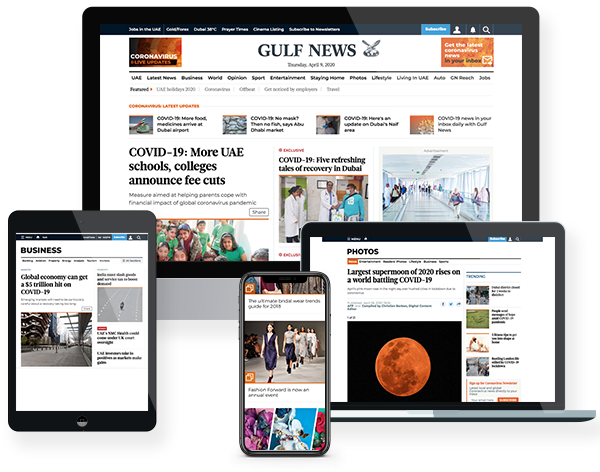
Dubai: Who wouldn’t like to have a strong sixth sense? That curious ability of people to know things that aren’t quite apparent. A sense that gives them information without using the basic five senses - sight, hearing, touch, smell, or taste.
If wearable technology develops in the direction it is anticipated to develop in, human beings soon might have that added edge in life.
That’s because every little part of our body is filled with data – it’s just not necessarily being read and analysed to provide us with usable information. Enter wearable technology.
From rings and wrist bands to even technology that can be ingested, technology has come a long way since Darth Vader walked around fitted in a bionic suit.
“When I started working in the area of bionic limbs 40 years ago, yes I was inspired by mannequins but also … Star Wars. You will remember the operation, where the nerves from the hand were being connected. It was science fiction at the time, it is true now,” Professor Paolo Dario, chief scientist at Dubai Future Labs, said at a panel discussion on bionics at the Dubai Future Forum.
“Today, there are some examples of technological creations that can feel the hardness and the temperature of an object. Not just that, scientists have been able to do something even more - making paralysed people able to walk again by nerve stimulation devices. Today, creating a connection between the external world and the nervous system is doable and we open the gate to a new field of cyborgs,” he added.
However, he also highlighted the obvious question that comes with it – what happens when the human body is connected to limbs that may be a lot stronger than the original human body?
“The role of education is important. Those of us who work in this field have a different kind of education because you must address not just the engineering problems but also the other questions that come up. We have been having debates on regulation or education – I am for education,” he said, referring to the greater role education plays in guiding an ethical approach to development of new technologies.
Listen to the community
Another speaker at the panel discussion on ‘Bionic beings’ was Ken Chua, the director at Singapore-based Inclusive Design & Technology Agency.
He spoke about the need for developers to pay attention to whether or not the wearable technology they are creating is of real benefit to the community, otherwise it runs the risk of becoming obscure.
“A good example is that of the wearable glove that translates sign language. Over the last eight years, there have been several such developments, but people don’t want to use it. Because when you take this technology to the deaf community, you will realise that it is immediately rejected by the community, because the technology is in a way rejecting sign language, which is part of the deaf pride and identity. People don’t want to use it. So, it is really about speaking to the community,” Chua said.
As someone who works closely with technology benefitting People of Determination, Chua said that the community of People of Determination can play a critical role in developing wearable technology for society at large.
“When it comes to a lot of the frontier technologies, People of Determination wait for years for it to trickle down to them. That’s where I try to put across a debate that we should be having People of Determination front and centre of this innovation, because when we apply such technology to those who live slightly different lives from us and look at what they do differently, it can help improve the experience of those who have a more neurotypical way of living. I think a good example is that of ‘autocomplete’ – the technology which predicts what you are about to type and provides you with suggestions. It allows us to lead faster lives. It was first developed for people with upper limb disabilities, because they would find it harder to type out complete sentences. Because we knew how to design for the extreme, we could design for all. So, let us look at the entire human spectrum and that is going to allow us to discover new innovations as sources of inspiration,” he said.
Augmenting life
Bionics, however, can become a helpful part of almost all spheres of life and at different levels.
Bionic suits, for example, can play a significant role in reducing workplace hazards in the construction industry. Similarly, when it comes to people older than 65 years, who are more prone to suffering from injuries due to falls, it can assist in specific cases like an AI-based elderly fall prediction system using wearable sensors.
Other examples are of diagnostic wearables, that can have a critical impact on cases such as Parkinson’s Diease.
“With Parkinson’s Disease, being able to offer a clinical score is extremely helpful. This would be an example of purpose-driven wearables,” Pawel Swieboda, who heads NeuroCentury, an advisory focused on brain, mental health and neurotechnology, said.
“There is better and better adoption of wearable technology. The figures have gone up to 1.1 billion connected devices in 2022, an increase from 600 million two years earlier. So, clearly there is a lot of progress. They are more comfortable and sensitive in measurement, but not all challenges have been overcome. One of the most intractable one is the material – the material has to be adaptable, something that follows the curvature of the body. There has been a lot of innovation, through the use of nano materials and polymers, but at the end of the day you need a semiconductor to be attached to it, which is a rigid presence,” Swieboda said.
He added, though, that as data centres became more connected and integrated, a paradigm shift is expected in wearable technology.
Imagine technology analysing your specific body makeup, health condition and vitals to deliver precision medicine that is tailored just for you.
“We will have a systemic change in the healthcare system. It is more and more obvious that we need to start to diagnose earlier and prevent disorders much earlier, so even heart attacks can now be traced to cholesterol levels going wrong in your adolescence. And wearables are an unbeatable way to address that problem,” he said.










